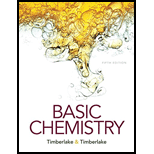
Concept explainers
Determine the pH for each of the following solutions: (11.6)
a.
b.
c.
d.
Want to see the full answer?
Check out a sample textbook solution
Chapter 14 Solutions
Basic Chemistry Plus Mastering Chemistry with Pearson eText -- Access Card Package (5th Edition)
- Common aspirin is acetylsalicylic acid, which has the structure shown below and a pKapKa of 3.5 (Figure 1). Calculate the pHpH of a solution in which one normal adult dose of aspirin (650 mgmg ) is dissolved in 10 ounces of water.arrow_forwardThe Kw for water at 100°C is 4.99 × 10-13. Calculate pKw for water at this temperature and the pH and the pOH for a neutral aqueous solution at 100°C. Report pH and pOH values to two decimal places.arrow_forwardThe chemical 5-amino-2,3-dihydro-1,4-phthalazinedione, better known as luminol, is used by forensic scientists in analyzing crime scenes for the presence of washed-away blood. Luminol is so sensitive that it can detect blood that has been diluted 10,000 times. A basic solution of luminol is often sprayed onto surfaces that are suspected of containing minute amounts of blood. Luminol has a molecular weight of 177 g/mol The technician must dilute the luminol solution to a concentration of 5.00×10−2 M . The diluted solution is then placed in a spray bottle for application on the desired surfaces. How many moles of luminol are present in 2.00 L of the diluted spray?arrow_forward
- 1)isothermic,exothermic, or endothermic 2)combustion,descombotion,synthesis,acid-base,double replacement,or single replacementarrow_forwardThe [H3O+] of ammonia is 8.3 x 10-11M. What is the pH of ammonia? Use 2 decimal places for pH.arrow_forwardAn aqueous solution at 25°C has OH^- concentration of 2. x 10^-4 M. Calculate H3O^+. Answer in 1 significant digitarrow_forward
- Options for question 1)lower or higher Options for question 2)lower or higher Options for question 3)stronger or weakerarrow_forwardAbove is the structure of Dextroamphetamine Sulfate with pKa = 10.01. What would be the net charge of this drug in the stomach? (pH = 2) What would be the net charge of this drug in the small intestine? (pH = 6.5-7) What would be the net charge of this drug in the blood? (pH = 7.4) Is this drug a weak base, a weak acid, or neutral?arrow_forwardCalculate the [H3O+] value of each aqueous solution.NaOH with [OH−]=1.4×10−2M Express your answer using two significant figures.arrow_forward
- 12. The increase in the concentration of carbon dioxide in the atmosphere has led to the ________ of the pH of the oceans. neutralization acidification decline increase More than one answer is correct. decreasearrow_forwardCalculate the [H3O+] value of each aqueous solution. milk of magnesia with [OH−]=1.2×10−5M .Express your answer using two significant figures.arrow_forwardFill in the following table: Fill in the following table: pH pOH [H+] / [H3O+] [OH-] A 9 B C D E F 1x10-4M G H 4.3x10-2M I J K L 2.1x10-3Marrow_forward
 Chemistry for Today: General, Organic, and Bioche...ChemistryISBN:9781305960060Author:Spencer L. Seager, Michael R. Slabaugh, Maren S. HansenPublisher:Cengage Learning
Chemistry for Today: General, Organic, and Bioche...ChemistryISBN:9781305960060Author:Spencer L. Seager, Michael R. Slabaugh, Maren S. HansenPublisher:Cengage Learning
